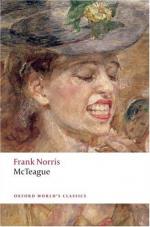McTeague spent the day in a fever of agitation, frightened out of his wits each time that Old Grannis left his elbow.
Old Grannis was delighted beyond measure at the prospect of acting the part of best man in the ceremony. This wedding in which he was to figure filled his mind with vague ideas and half-formed thoughts. He found himself continually wondering what Miss Baker would think of it. During all that day he was in a reflective mood.
“Marriage is a—a noble institution, is it not, Doctor?” he observed to McTeague. “The—the foundation of society. It is not good that man should be alone. No, no,” he added, pensively, “it is not good.”
“Huh? Yes, yes,” McTeague answered, his eyes in the air, hardly hearing him. “Do you think the rooms are all right? Let’s go in and look at them again.”
They went down the hall to where the new rooms were situated, and the dentist inspected them for the twentieth time.
The rooms were three in number—first, the sitting-room, which was also the dining-room; then the bedroom, and back of this the tiny kitchen.
The sitting-room was particularly charming. Clean matting covered the floor, and two or three bright colored rugs were scattered here and there. The backs of the chairs were hung with knitted worsted tidies, very gay. The bay window should have been occupied by Trina’s sewing machine, but this had been moved to the other side of the room to give place to a little black walnut table with spiral legs, before which the pair were to be married. In one corner stood the parlor melodeon, a family possession of the Sieppes, but given now to Trina as one of her parents’ wedding presents. Three pictures hung upon the walls. Two were companion pieces. One of these represented a little boy wearing huge spectacles and trying to smoke an enormous pipe. This was called “I’m Grandpa,” the title being printed in large black letters; the companion picture was entitled “I’m Grandma,” a little girl in cap and “specs,” wearing mitts, and knitting. These pictures were hung on either side of the mantelpiece. The other picture was quite an affair, very large and striking. It was a colored lithograph of two little golden-haired girls in their nightgowns. They were kneeling down and saying their prayers; their eyes—very large and very blue—rolled upward. This picture had for name, “Faith,” and was bordered with a red plush mat and a frame of imitation beaten brass.
A door hung with chenille portieres—a bargain at two dollars and a half—admitted one to the bedroom. The bedroom could boast a carpet, three-ply ingrain, the design being bunches of red and green flowers in yellow baskets on a white ground. The wall-paper was admirable—hundreds and hundreds of tiny Japanese mandarins, all identically alike, helping hundreds of almond-eyed ladies into hundreds of impossible junks, while hundreds of bamboo palms overshadowed the pair, and hundreds of long-legged storks trailed contemptuously away from the scene. This room was prolific in pictures. Most of them were framed colored prints from Christmas editions of the London “Graphic” and “Illustrated News,” the subject of each picture inevitably involving very alert fox terriers and very pretty moon-faced little girls.




